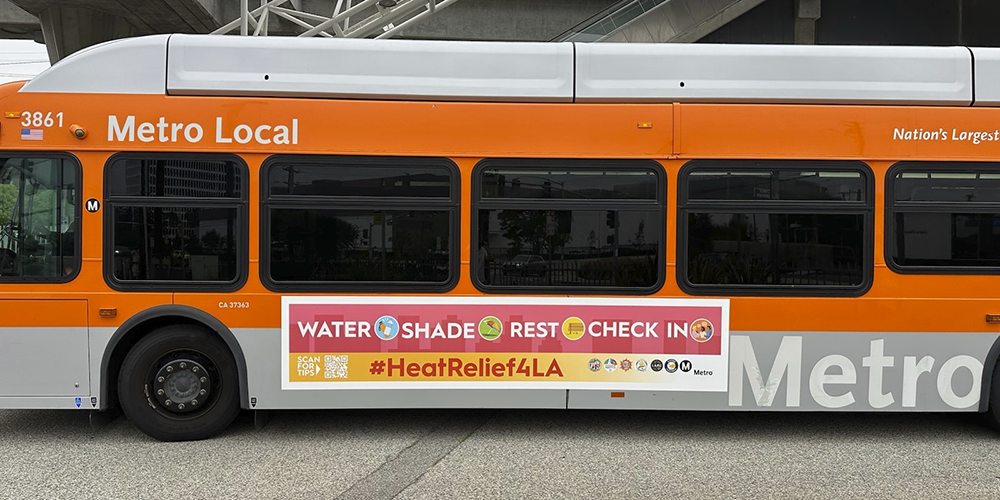Effectively communicating about heat risk requires deep community engagement
To reach heat-impacted communities, LCI report recommends heat communicators combine outreach strategies into targeted campaigns
A bus ad created for the 2023 #HeatSafeLA campaign and distributed by LA City’s Climate Emergency Mobilization Office. Credit: Tom Watanabe
As climate change brings more intense and frequent extreme weather events, government and community leaders are raising awareness and providing resources to those at risk. Strong public outreach and community engagement can potentially help safeguard people from heat, from the acute threats of heat waves to the pernicious effects of chronically high temperatures. But how, when, and to whom should communicators disseminate information?
To help answer these questions, a new Luskin Center for Innovation (LCI) report provides guidance based on insights from heat communication practitioners and recent awareness campaigns in California. The report, “Communicating Heat Risk: A guide to inclusive, effective, and coordinated public information campaigns,” lays out the following five recommendation areas for communicators :
- Deeply engage with heat-impacted communities. Identify the most heat-impacted communities (e.g., young children, outdoor workers, and unhoused people), then collaborate with them to understand their needs and communication preferences.
- Use strategic timing and inclusive messaging to convey the serious health threat from heat exposure.Conveying the life-threatening nature of heat is essential and requires nuanced, tailored messaging; well-timed outreach throughout the year; and careful consideration of the variation of needs and barriers faced by communities. For example, accurately translating materials into several languages can make communications more inclusive and relevant to target audiences.
- Build campaigns that use a wide array of tactics and prioritize utilizing trusted messenger networks. No one (or two, or three) communication channel will reach everyone harmed by heat, but some tactics may work better than others — especially communicating through community-trusted, local organizations and leaders.
- Share responsibilities with the state as a coordinator and locals as on-the-ground communicators. State and local governments alike should embrace an all-hands-on-deck approach to collaboration that makes use of state resources to create consistency and local knowledge to reach affected communities effectively.
- Take multiple approaches to evaluating communication efforts, with community knowledge at the center. While evaluation is difficult (especially with present data and research limitations), communicators can learn substantial lessons from the communities they hope to reach — such as where they go to get information and what current efforts lack.
The report presents findings and insights from 15 interviews with heat communication experts and practitioners, drawing on experiences within California and from cities across the country. It also builds on LCI’s growing body of heat equity research, including the “Guidance for an Equitable and Effective Extreme Heat Strategy in California” policy brief series.
This work was made possible through the support of the Accelerate Resilience L.A., a sponsored project of Rockefeller Philanthropy Advisors.








